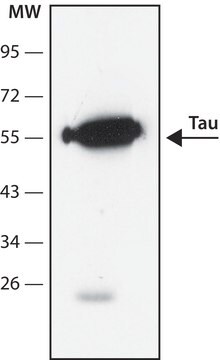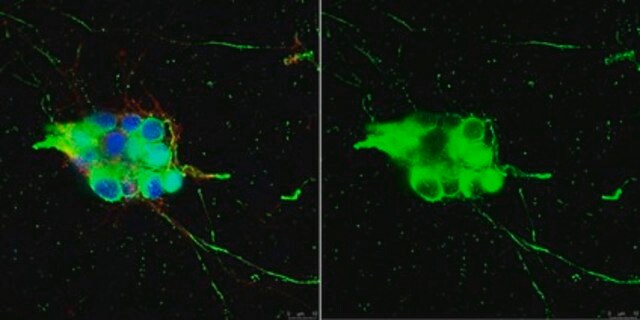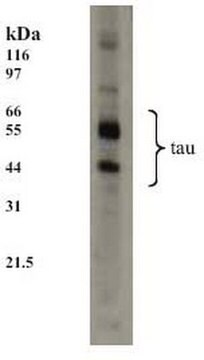N5788
Anti-Nerve Growth Factor Receptor/TNFRSF16 antibody produced in goat
affinity isolated antibody, lyophilized powder
Synonym(s):
Anti-LNGFR, Anti-Ngfr, Anti-Tnfrsf16, Anti-p75
Sign Into View Organizational & Contract Pricing
All Photos(1)
About This Item
Recommended Products
biological source
goat
Quality Level
conjugate
unconjugated
antibody form
affinity isolated antibody
antibody product type
primary antibodies
clone
polyclonal
form
lyophilized powder
species reactivity
mouse
technique(s)
immunohistochemistry: 5-15 μg/mL
western blot: 2 μg/mL
UniProt accession no.
storage temp.
−20°C
target post-translational modification
unmodified
Gene Information
mouse ... Ngfr(18053)
Looking for similar products? Visit Product Comparison Guide
Related Categories
General description
Neurotrophins (NT) are growth factors that are essential for the development and maintenance of the nervous system. One of the receptors that mediate the effects of NTs is the Nerve Growth Factor Receptor/TNFRSF16 (p75NGFR, p75NTR). Nerve growth factor (NGF) binds to either to NGF receptor (NGFR) or the Trk receptor and can elicit biological responses through each of the receptors independently. NGFR mediates the effects of NGF that are important in the survival and differentiation of neurons and neural crest-derived cells during embryonic and early postnatal development and maintenance of peripheral neurons. Signaling of NGF through NGFR is also implicated in inflammation and allergic reactions. Expression of NGFR has been associated with favourable prognosis and survival in breast and pancreatic cancers
Anti-Nerve Growth Factor Receptor/TNFRSF16 recognizes mouse NGF R.
Anti-Nerve Growth Factor Receptor/TNFRSF16 recognizes mouse NGF R.
Immunogen
purified, NSO cell-derived recombinant mouse nerve growth factor receptor extracellular domain.
Application
Anti-Nerve Growth Factor Receptor/TNFRSF16 antibody may be used for immunoblotting at a working concentration of 2 μg/ml. For immunohistochemistry a working concentration of 5-15 μg/ml is recommended.
Target description
Anti-Nerve Growth Factor Receptor/TNFRSF16 recognizes mouse NGF R. Neurotrophic factors control the survival, differentiation and maintenance of neurons in the peripheral and central nervous systems, and of other neural crest-derived cell types.
Physical form
Lyophilized from a 0.2 μm filtered solution in phosphate buffered saline containing carbohydrates.
Disclaimer
Unless otherwise stated in our catalog or other company documentation accompanying the product(s), our products are intended for research use only and are not to be used for any other purpose, which includes but is not limited to, unauthorized commercial uses, in vitro diagnostic uses, ex vivo or in vivo therapeutic uses or any type of consumption or application to humans or animals.
Not finding the right product?
Try our Product Selector Tool.
related product
Product No.
Description
Pricing
Storage Class Code
13 - Non Combustible Solids
WGK
WGK 1
Flash Point(F)
Not applicable
Flash Point(C)
Not applicable
Personal Protective Equipment
dust mask type N95 (US), Eyeshields, Gloves
Choose from one of the most recent versions:
Already Own This Product?
Find documentation for the products that you have recently purchased in the Document Library.
E V Kuzhikandathil et al.
Pharmaceutical research, 29(8), 2264-2275 (2012-05-02)
The D3 dopamine receptor exhibits tolerance and slow response termination (SRT) properties that are not exhibited by the closely-related D2 dopamine receptor. We previously demonstrated that the induction of tolerance elicits a unique conformational change in the D3 receptor. Here
Stephanie R Shepheard et al.
PloS one, 9(1), e87398-e87398 (2014-01-30)
Objective biomarkers for amyotrophic lateral sclerosis would facilitate the discovery of new treatments. The common neurotrophin receptor p75 is up regulated and the extracellular domain cleaved from injured neurons and peripheral glia in amyotrophic lateral sclerosis. We have tested the
Nerve growth factor and the physiology of pain: lessons from congenital insensitivity to pain with anhidrosis
Indo Y
Clinical Genetics, 82, 341-350 (2010)
Yong Zhang et al.
Oncology reports, 14(1), 161-171 (2005-06-10)
Nerve growth factor (NGF), the prototypic member of the neurotrophin family of growth factors, exerts both stimulatory and inhibitory effects on neuronal and certain non-neuronal tumors, depending on the type of tumor. It has been reported that two types of
Wolfgang Andreas Nockher et al.
The Journal of allergy and clinical immunology, 117(3), 583-589 (2006-03-09)
Understanding the complex pathophysiology of allergic diseases has been a main challenge of clinical and experimental research for many years. It is well known that the allergic inflammation triggers neuronal dysfunction and structural changes in the diseased tissues such as
Our team of scientists has experience in all areas of research including Life Science, Material Science, Chemical Synthesis, Chromatography, Analytical and many others.
Contact Technical Service







